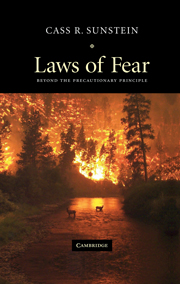8 - Libertarian Paternalism
Published online by Cambridge University Press: 05 September 2012
Summary
To engage in cost-benefit analysis, regulators need to know a great deal. Often they won't know enough to produce an analysis in which they can have any confidence. What might they do instead? Sometimes an Anti-Catastrophe Principle makes a lot of sense, but its domain is restricted (fortunately). My goal in this chapter is to sketch an alternative approach, one that is especially designed for cases in which people are insufficiently fearful, but that also has potential applications in cases in which people's fear is excessive.
OF SAVINGS AND CHOICES
Begin with two studies of savings behavior:
Hoping to increase savings by workers, several employers have adopted a simple strategy. Instead of asking workers to elect to participate in a 401(k) (i.e., savings for retirement) plan, workers will be assumed to want to participate in such a plan, and hence they will be enrolled automatically unless they specifically choose otherwise. This simple change in the default rule has produced dramatic increases in enrollment.
Rather than changing the default rule, some employers have provided their employees with a novel option: Allocate a portion of future wage increases to savings. Employees who choose this plan are free to opt out at any time. A large number of employees have agreed to try the plan, and only a few have opted out. The result has been significant increases in savings rates.
- Type
- Chapter
- Information
- Laws of FearBeyond the Precautionary Principle, pp. 175 - 203Publisher: Cambridge University PressPrint publication year: 2005
- 1
- Cited by



